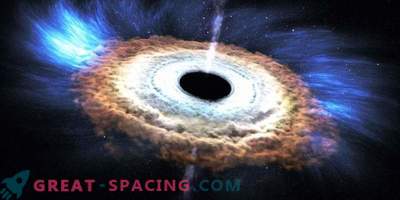
In a galaxy located at a distance of 600 million light years from Earth, black holes in a battle to the death are tearing apart space-time, revealing some interesting dynamics in the center of a powerful quasar.
The quasar located in the center of the Markaryan 231 galaxy (Mrk 231) is the closest quasar to Earth and after several years of studying the data obtained by the Hubble Space Telescope, the astronomers team realized that this quasar is powered by two black holes in an orbital mortal combat.
This can be crucial for the study of quasars - super-bright bursts of energy located in remote parts of the Universe. But the fact that we have a quasar located relatively close by galactic standards represents a good opportunity to study these mysterious objects.
In the study of ultraviolet emissions of an accretion disk of a quasar (a disk of superheated gases surrounding the central region), an amazing discovery was made: a quasar appears to have a ring shape. Using dynamic models, researchers quickly realized that there should be two supermassive black holes, one of which is slightly smaller than the other. While they rotate inside the core of a quasar, the smaller of the black holes cuts the area on the inside, forming its own smaller accretion disk. Calculations show that this pair passes a full orbit for every 1, 2 years. The big black hole is about 150 million times more massive than our Sun, and smaller than 4 million times.
"We were very happy to make this discovery, not only because it shows the existence of a tight double black hole in Mrk 231, but also paves the way for systematic search for double black holes using the nature of their ultraviolet light radiation," said Yojun Liu of National Astronomical Observatory of China, Chinese Academy of Sciences.
As the two black holes spiral around each other, in a few hundred thousand years they will collide and merge.
The presence of 2 supermassive blacks in the center of the quasar speaks of the turbulent past of Mrk 231.
Known as the “star-forming galaxy,” it is the site of star formation, spawning stars at a rate 100 times faster than our Milky Way galaxy. Once, a smaller galaxy collided with Mrk 231, forming a long tail of young blue stars. The galaxy also has an asymmetrical shape, showing us that billions of stars are still in the process of being settled. It is likely that the smaller black hole was in the center of the colliding galaxy. "In the structure of our universe, there are giant galaxies and clusters of galaxies that grew by merging smaller ones into larger ones, and binary black holes are the natural result of these mergers," added co-researcher Xuyu Day from the University of Oklahoma.
The tidal effect also generated a huge amount of gas, fueling a huge black hole and a bright quasar.











































